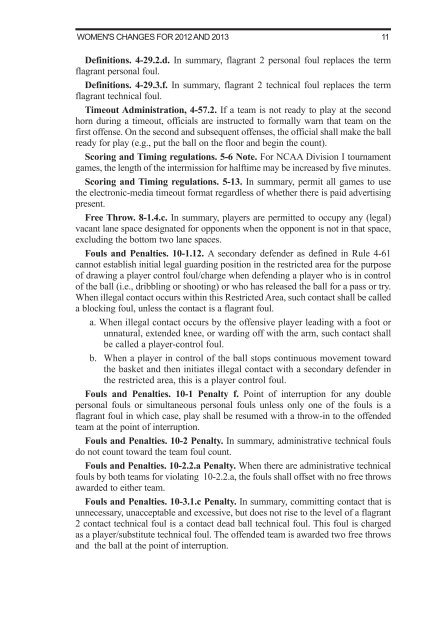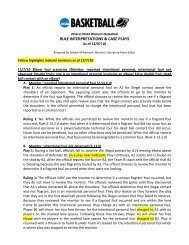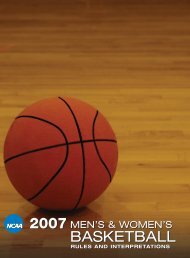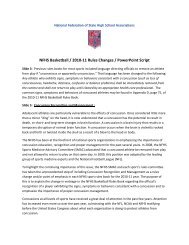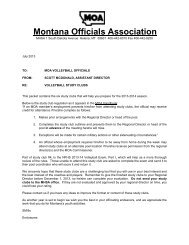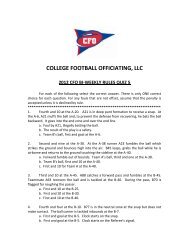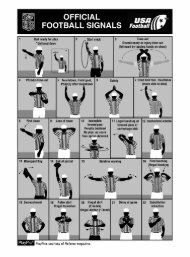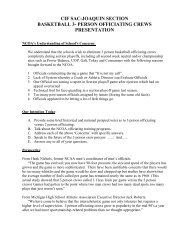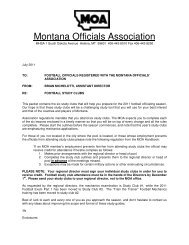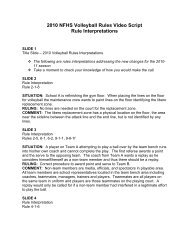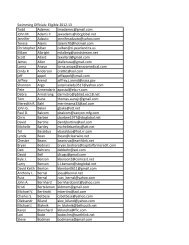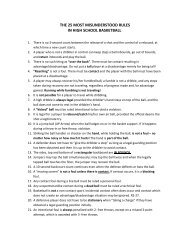2011-12 AND 2012-13 MEN'S AND WOMEN'S RULES - NAIA
2011-12 AND 2012-13 MEN'S AND WOMEN'S RULES - NAIA
2011-12 AND 2012-13 MEN'S AND WOMEN'S RULES - NAIA
You also want an ePaper? Increase the reach of your titles
YUMPU automatically turns print PDFs into web optimized ePapers that Google loves.
Women's Changes for 20<strong>12</strong> and 20<strong>13</strong>11<br />
Definitions. 4-29.2.d. In summary, flagrant 2 personal foul replaces the term<br />
flagrant personal foul.<br />
Definitions. 4-29.3.f. In summary, flagrant 2 technical foul replaces the term<br />
flagrant technical foul.<br />
Timeout Administration, 4-57.2. If a team is not ready to play at the second<br />
horn during a timeout, officials are instructed to formally warn that team on the<br />
first offense. On the second and subsequent offenses, the official shall make the ball<br />
ready for play (e.g., put the ball on the floor and begin the count).<br />
Scoring and Timing regulations. 5-6 Note. For NCAA Division I tournament<br />
games, the length of the intermission for halftime may be increased by five minutes.<br />
Scoring and Timing regulations. 5-<strong>13</strong>. In summary, permit all games to use<br />
the electronic-media timeout format regardless of whether there is paid advertising<br />
present.<br />
Free Throw. 8-1.4.c. In summary, players are permitted to occupy any (legal)<br />
vacant lane space designated for opponents when the opponent is not in that space,<br />
excluding the bottom two lane spaces.<br />
Fouls and Penalties. 10-1.<strong>12</strong>. A secondary defender as defined in Rule 4-61<br />
cannot establish initial legal guarding position in the restricted area for the purpose<br />
of drawing a player control foul/charge when defending a player who is in control<br />
of the ball (i.e., dribbling or shooting) or who has released the ball for a pass or try.<br />
When illegal contact occurs within this Restricted Area, such contact shall be called<br />
a blocking foul, unless the contact is a flagrant foul.<br />
a. When illegal contact occurs by the offensive player leading with a foot or<br />
unnatural, extended knee, or warding off with the arm, such contact shall<br />
be called a player-control foul.<br />
b. When a player in control of the ball stops continuous movement toward<br />
the basket and then initiates illegal contact with a secondary defender in<br />
the restricted area, this is a player control foul.<br />
Fouls and Penalties. 10-1 Penalty f. Point of interruption for any double<br />
personal fouls or simultaneous personal fouls unless only one of the fouls is a<br />
flagrant foul in which case, play shall be resumed with a throw-in to the offended<br />
team at the point of interruption.<br />
Fouls and Penalties. 10-2 Penalty. In summary, administrative technical fouls<br />
do not count toward the team foul count.<br />
Fouls and Penalties. 10-2.2.a Penalty. When there are administrative technical<br />
fouls by both teams for violating 10-2.2.a, the fouls shall offset with no free throws<br />
awarded to either team.<br />
Fouls and Penalties. 10-3.1.c Penalty. In summary, committing contact that is<br />
unnecessary, unacceptable and excessive, but does not rise to the level of a flagrant<br />
2 contact technical foul is a contact dead ball technical foul. This foul is charged<br />
as a player/substitute technical foul. The offended team is awarded two free throws<br />
and the ball at the point of interruption.


